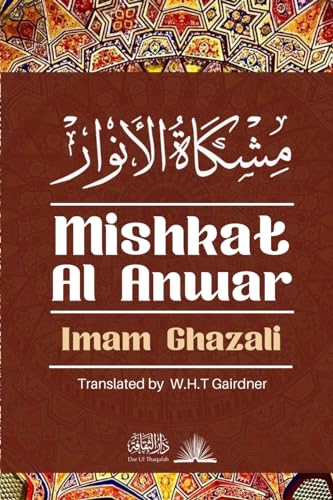Mishkat Al Anwar – The Niche for lights
Imam Ghazali
Paperback, 106 Pages, Black & White
6 x 9 Inches
Dar Ul Thaqafah
The Mishkat Al-Anwar, literally translated “The Niche for Lights,” is a theological and philosophical sufi text by the well-known Muhammad Al-Ghazzali. Though the exact date of its writing is unknown, it was authored after his opus Ihya’ ulum al-din, or Revival of Religious Sciences. The work focuses on expanding upon the meaning behind a verse in the Qu’ran-the Light Verse (S. 24, 35)-and upon the Veils Tradition in Islam.
The book is divided into three sections; in the first Al-Ghazali deconstructs the word “light” and all its meanings, in the second he discusses the symbolic language in the Qu’ran and Muslim traditions, and in the third he applies his findings to the verse and tradition itself.
Abu hamed Muhammad ibn Muhammad Al Ghazali (1058-1111) was a Persian Islamic philosopher, theologian, psychologist, and mystic, known today as one of the most famous Sunni scholars in history, sometimes cited as next-in-importance only to Muhammad. Born in Tus, Al-Ghazzali was a pioneer of methodic doubt; his work The Incoherence of Philosophers shifted early Islamic philosophy from metaphysics to the theory of occasionalism, an Islamic doctrine that states cause-and-effect is controlled by God. He also succeeded in bringing orthodox Islam in contact with Sufism. The author of more than 70 books on various subjects, his influence continues to stretch far and wide even today.
Table of Contents:
PART I. LIGHT, ANT) LIGHTS: Preliminary Studies
1. Light as Physical Light; as the Eye; as the Intelligence
2. The Koran as the Sun of the Intelligence
3. The Worlds Visible and Invisible; with their Lights
4. These Lights as Lamps Terrestrial and Celestial; with their Order and Grades
5. The Source of all these Grades of Light, ALLAH
6. The Mystic Verity of Verities.
7. The ” God- Aspect “: an ” advanced ” explanation of the Relation of these Lights to ALLAH
8. The Relation of these Lights to ALLAH: simpler illustrations and explanations
PART II. THE SCIENCE OF SYMBOLISM.
(i) The Outward and the inward in Symbolism: Type and Antitype
1. The Two Worlds: their Types and Antitypes
2. An example of symbolism, from the story of Abraham in the Koran
3. Fundamental examples of symbolism: especially from the story of Moses in the Koran
4. The permanent validity of the Outward and Visible Sign: an example
5. Another example of this two-sided and equal validity of Outward and Inward
(ii) The Psychology of the Human Soul its Five Faculties, or Spirits
PART III. THE APPLICATION OF ALL THE FOREGOING TO THE LIGHT-VERSE AND THE VEILS-TRADITION
(i) The Exposition of the Symbolism of the Light-Verse
1. The Sensory Spirit
2. The Imaginative Spirit.
3. The Intelligential Spirit
4. The Ratiocinative Spirit.
5. The Transcendental Prophetic Spirit
Epilogue : the ” Darkness “-Verse
(ii) The Exposition of the Symbolism of the Seventy Thousand Veils
1. Those veiled by pure Darkness
2. Those veiled by mixed Light and Darkness
(a) The darkness of the Senses
(6) The darkness of the Imagination
(c) The darkness of the (ratiocinative) Intelligence
3. Those veiled by pure Light
4. The Goal of the Quest





